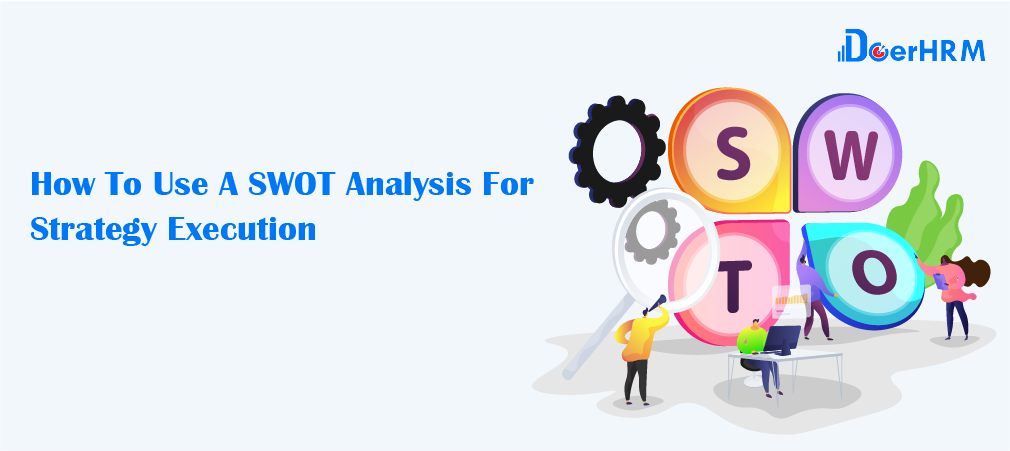Historically, corporate planning has always been difficult. Many organizations have failed at trying to get everyone on the same page and agree to the details of a plan—more often than not, their efforts proved to be both ineffective and time consuming. Something had to be done.
Albert Humphrey of the Stanford Research Institute determined in the 1960s to identify why corporate planning consistently failed. Thus the origination of the SWOT analysis. Today, the SWOT analysis is one of the most important concepts in the business world and is widely used by all types of organizations to help build a strategic plan.
So, what is a SWOT analysis, and what do you do with it? In this article, we’ll explain it all (and share some SWOT analysis examples to boot) from start to finish.
What is a SWOT analysis?
A SWOT analysis is a high-level strategic planning model that helps organizations identify where they’re doing well and where they can improve, both from an internal and an external perspective. SWOT is an acronym for “Strengths, Weaknesses, Opportunities, and Threats.”
SWOT works because it helps you evaluate your business by considering multiple factors:
- Strengths and weaknesses are internal factors (things you can control), like team members, software, and geographic location.
- Opportunities and threats represent external factors (things you can’t control), such as competitors, regulations, and economic trends.
Organizations use SWOT to plot out a future course that plays on their strengths and minimizes risks. Taking the time to look at your organization from different perspectives and honestly assess your future prospects is a worthwhile activity; the insights you glean as a result you should then use constructively as part of the strategic planning process.
How do you conduct a SWOT analysis?
To help you get started, we’ve created this step-by-step SWOT analysis template. The examples below are specific to the airline industry (since that’s the example we use in our grid), but the SWOT analysis exercise is applicable to all businesses.
You’ll notice we divided our hypothetical examples for strengths, weaknesses, opportunities, and threats based on the four Balanced Scorecard perspectives. You don’t have to use the Balanced Scorecard to be successful with your SWOT analysis, but this method does provide a strong framework for your discussion.
Not using the Balanced Scorecard? Look to the guiding principles of whatever strategic management framework you are using for ways to think about your business. For example, the VRIO framework emphasizes value, rarity, imitability, and organization; you can conduct a SWOT analysis through the lens of these criteria instead.
1. Create a SWOT matrix
This is the grid-like matrix that will house the information you gather. As you can see in the SWOT analysis template below, each quadrant features one of the four elements you’ll be focusing on—strengths, weaknesses, opportunities, and threats. Using a matrix helps present your findings in a clear, easy-to-understand way.
To help you get started, we’ve created this step-by-step SWOT analysis template. The examples below are specific to the airline industry (since that’s the example we use in our grid), but the SWOT analysis exercise is applicable to all businesses.
You’ll notice we divided our hypothetical examples for strengths, weaknesses, opportunities, and threats based on the four Balanced Scorecard perspectives. You don’t have to use the Balanced Scorecard to be successful with your SWOT analysis, but this method does provide a strong framework for your discussion.
Not using the Balanced Scorecard? Look to the guiding principles of whatever strategic management framework you are using for ways to think about your business. For example, the VRIO framework emphasizes value, rarity, imitability, and organization; you can conduct a SWOT analysis through the lens of these criteria instead.
2. Gather the right participants
Pull people from all departments to participate in the analysis. Your entire leadership team should be involved because they can provide a broad view of the organization and offer insight into the competitive landscape. But having lots of different perspectives is beneficial, and that means including leaders from every department—and anyone else you think might have valuable input. The more diverse the group, the better insights you’ll generate. Not all ideas will make it to the final list, but it’s important to consider them all.
3. List your strengths
Ask the group: What are we good at? How are we better than our competitors? These are broad questions, but in the beginning stages of your discussion, you should accept all answers.
Examine these questions in relation to the Balanced Scorecard perspectives. For the fictional company Upward Airlines, the discussion might look like this:
- Financial strengths: What is our most reliable source of financial growth? Is it our service destinations? A large fleet size? Our customer loyalty program?
- Customer strengths: Where is our customer growth coming from? Is it due to excellent service ratings or low prices? Why are customers choosing us over our competitors?
- Internal strengths: What do we do very well as an organization? Are our operations easily scalable? Do we have an exceptionally high employee retention rate? How complex is our maintenance program?
- Learning & growth strengths: Where do we excel as far as our employees are concerned? Is it our compensation model? Could it be our workforce development program? Are people coming or leaving because of our culture?
4. List your weaknesses
Ask the group: What are we not good at? Where can we grow? What are we lacking? The Upward Airlines discussion might look like this:
- Financial weaknesses: What is our biggest financial weakness? Our destinations are all in the U.S., which may be limiting our growth. Or, we know that a large number of new competitors entering the market are decreasing our market share. Do we have challenges with debt or credit?
- Customer weaknesses: Where do our customers think we need to improve? This could be related to frequently canceled flights, lost baggage, complexity of the reservation process, or cleanliness, for instance.
- Internal weaknesses: What do we do poorly? Are we slow at handling customer complaints? Are our maintenance costs above industry average? What about plane utilization?
- Learning & growth weaknesses: What are our biggest challenges with employees? Is our staff security training proving ineffective, or is there a negative perception of the organizational culture? Do our employee surveys reveal low engagement?
5. Identify your opportunities
Ask the group: Where do we see big (and small) possibilities for our organization? What do we see happening in the future?
The Upward Airlines group might discuss the following:
- Financial opportunities: What is our biggest opportunity to improve our finances? This might mean taking advantage of federal loans in a time of crisis (like COVID-19) or adopting specific technology to lower costs. Maybe there is an opportunity to purchase a weaker competitor.
- Customer opportunities: Where could we dramatically improve with our customers? Could we enhance our online interface? Can we create and promote new standards of cleanliness? What about finding new ways to engage with customers when travel opportunities are low?
- Internal opportunities: What processes will drive us well into the future if we could improve upon them? Adopting certain climate initiatives to reduce our carbon footprint, for instance, will make us more eco-friendly (and, by extension, more appealing to customers). Maybe now is the time to upgrade a reservation or pricing system.
- Learning & growth opportunities: What opportunities do we have to leverage staff? For example, do we have cross-training opportunities? Could we make a few tweaks to improve our culture and thus our retention?
6. Identify your potential threats
Ask the group: What do we see as a threat? What obstacles do we anticipate? What is changing that could hurt us? As a travel-related company in a tough economy, Upward Airlines might uncover a number of potential threats:
- Financial threats: What threats could seriously impact our financial health? This could be low-cost competitors, ongoing global health issues that prevent travel, or rising oil costs.
- Customer threats: What is our biggest concern about our customers? Has a competitor created a more attractive loyalty program? Is our number of business clients trending downward?
- Internal threats: What current areas of our business might harm us later? Is a contract dispute imminent that could disrupt business? Is a potential merger or acquisition on the horizon?
- Learning & growth threats: What threatens the people within your organization? This could be anything from instability in our customer support department to staff member departures to a department-specific pushback against new technology.
7. Examine your matrix for connections
In looking at your SWOT matrix, do some of your strengths naturally support the identified opportunities? If you eliminate weaknesses, would that present additional opportunities?
Your SWOT analysis is now complete! At this point, we recommend running a “brown paper exercise”—print your SWOT matrix in large size, and ask employees to add post-it notes in any or all of the matrix’s four boxes if they feel the leadership team missed something. (You can also ask employees to add their names next to their suggestions so leadership can follow up with them.) Not only is this exercise great for inter-office discussion, but it also gives leaders the chance to consider opinions from staff in the field.
Done correctly, the SWOT analysis is another valuable tool in your toolbox for improving business performance and minimizing threats and weaknesses going forward. It can also prompt organizations to be more innovative with their strategy—new ideas may emerge that leadership would not normally have considered without such a thorough examination of the business from all angles.
Conclusion
A SWOT analysis is a great way to guide business-strategy meetings. It’s powerful to have everyone in the room discuss the company’s core strengths and weaknesses, define the opportunities and threats, and brainstorm ideas. Oftentimes, the SWOT analysis you envision before the session changes throughout to reflect factors you were unaware of and would never have captured if not for the group’s input.
A company can use a SWOT for overall business strategy sessions or for a specific segment such as marketing, production, or sales. This way, you can see how the overall strategy developed from the SWOT analysis will filter down to the segments below before committing to it. You can also work in reverse with a segment-specific SWOT analysis that feeds into an overall SWOT analysis.






